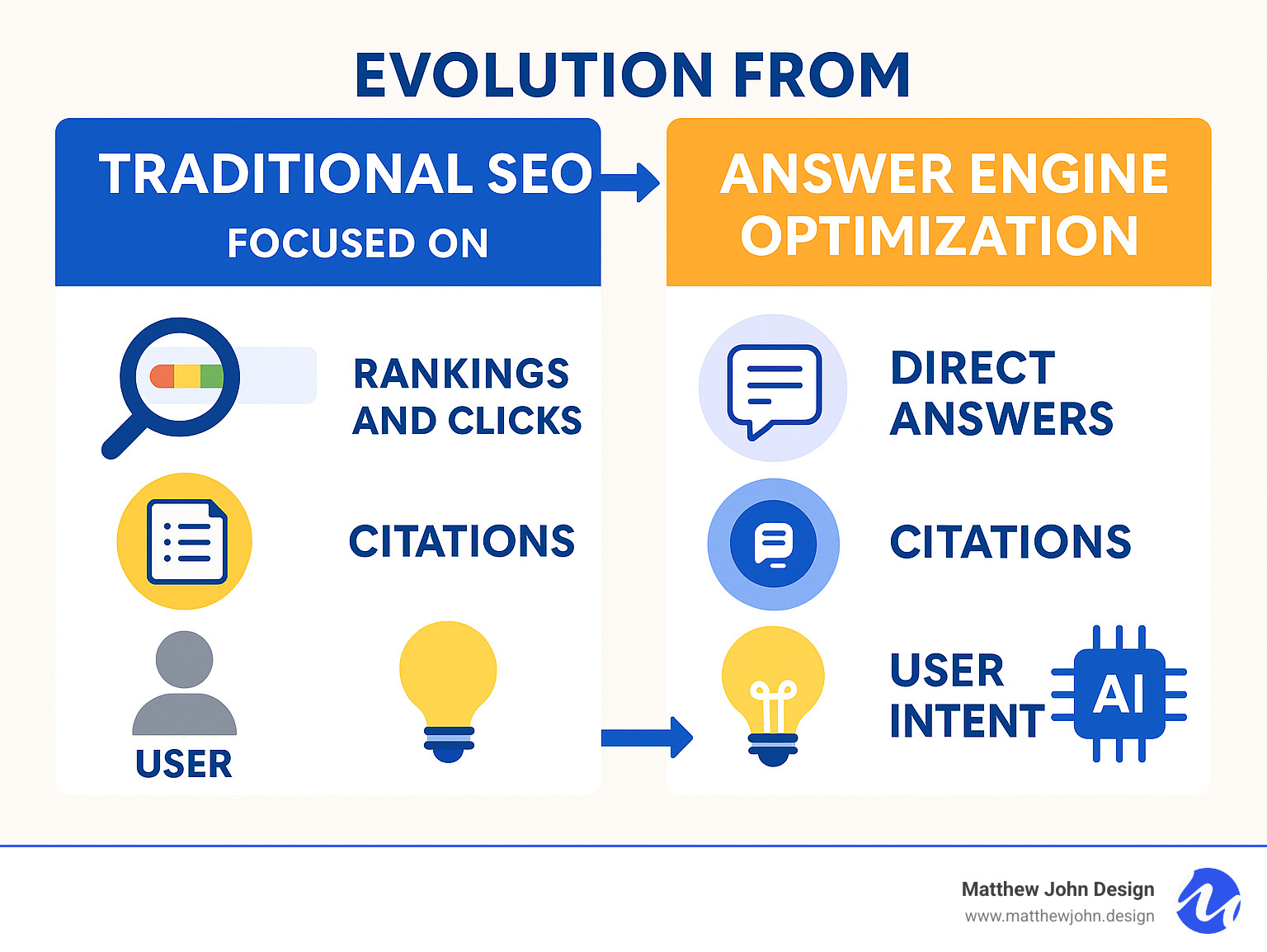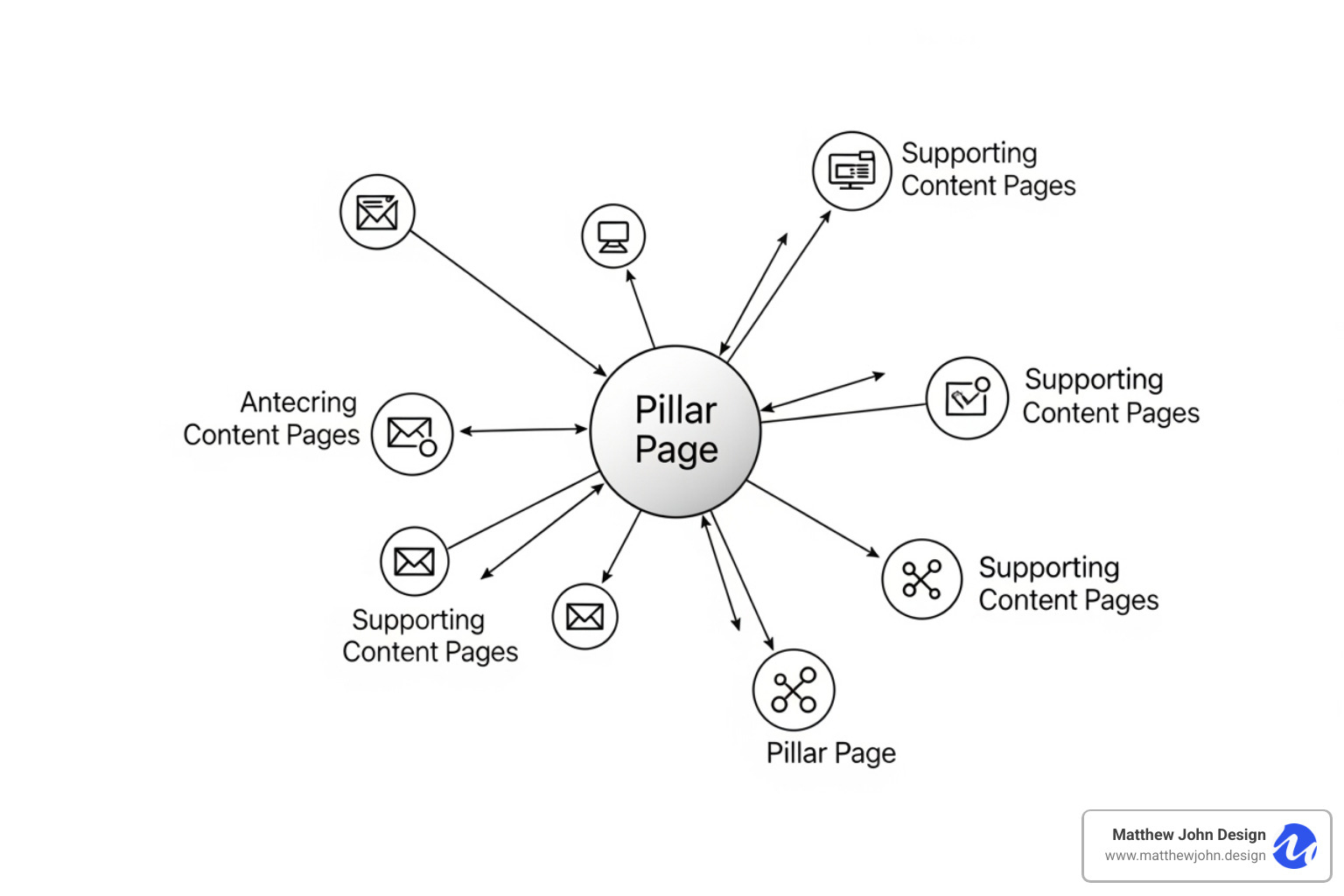Any information contained on this Website is not legal advice and should not be treated as such. You should always contact an attorney for help with your specific legal needs and issues. We may also earn a commission when you click links to our partners and purchase goods or services. For more information, read our Disclaimers Policy.
Why Answer Engine Optimization Best Practices Matter in 2025
Answer engine optimization best practices are reshaping how businesses get finded online. Unlike traditional SEO that focuses on ranking web pages, AEO helps your content become the direct answer users receive from AI chatbots, voice assistants, and search engine features.
Quick Answer Engine Optimization Best Practices:
- Focus on user intent - Structure content around questions your audience actually asks
- Provide direct answers - Lead with concise, 40-60 word responses to key questions
- Use structured data - Implement FAQPage, HowTo, and QAPage schema markup
- Build topical authority - Create comprehensive content clusters around core topics
- Optimize for voice search - Use natural, conversational language and long-tail keywords
- Monitor performance - Track featured snippets and high-impression, low-click queries
The shift is happening faster than most realize. With approximately 60% of Google searches in 2024 resulting in zero clicks, users are getting answers without visiting websites. Gartner predicts that by 2026, 25% of organic search traffic will shift to AI chatbots and virtual assistants.
This isn't just about traffic numbers. Companies like NerdWallet saw 35% revenue growth despite 20% less website traffic by adapting to this new landscape. Meanwhile, Stack Overflow experienced an 18% drop in visits after ChatGPT became popular.
The businesses winning in 2025 understand that visibility now means being cited, not just ranked. Answer engines like ChatGPT, Perplexity, Google's AI Overviews, and voice assistants are becoming the primary way people find information.

The Shift to Answers: Why AEO is Crucial for Visibility in 2025
The digital landscape is shifting. For years, SEO focused on ranking high in search results to earn clicks. Now, the game has changed. Users expect immediate answers directly on the results page or from AI assistants, often without visiting a website.
This trend is known as a "zero-click search." A recent SparkToro study found that in the US, only 360 clicks per 1,000 Google searches go to a website. This means over half of searches end without a click, a fundamental user behavior shift driven by AI.
This is why answer engine optimization best practices are crucial. Businesses must adapt to how people now find information, moving from a world of "search engines" to one of "answer engines."
Gartner predicts that by 2026, 25% of organic search traffic will go directly to AI chatbots and virtual assistants. This is a shift in visibility, not a loss of it. For example, NerdWallet saw 35% revenue growth despite a 20% traffic drop by adapting to be the direct source for answers. Conversely, Stack Overflow saw an 18% drop in visits after ChatGPT's rise, showing the impact of direct AI answers.
To thrive, we must understand and optimize for these answer engines. Answer engine optimization best practices ensure your content is not just found, but used by AI to answer queries. For more on how AI is reshaping content, explore our insights on AI-driven content strategy.
Understanding the Main Types of Answer Engines
Before diving into answer engine optimization best practices, it's helpful to know the main types of answer engines. These AI-driven systems are designed to give direct, concise responses by processing vast amounts of data.
- Generative AI Chatbots: These conversational AI models produce human-like text responses. They synthesize information from training data and web searches to provide comprehensive answers. Key examples include ChatGPT, Perplexity AI (which cites its sources), and Google Gemini, which is integrated into search.
- Generative AI Voice Assistants: These AI-powered helpers respond to spoken commands. They pull information from web snippets and knowledge bases. Common assistants are Apple's Siri, Google Assistant, and Amazon's Alexa.
A key feature of these engines is multimodality—the ability to process and combine information from text, images, video, and audio. This means a comprehensive content strategy should include diverse media types.
How AEO Differs from Traditional SEO
While both AEO and traditional SEO aim for online visibility, their approaches differ significantly. AEO focuses on providing the direct answer, while traditional SEO focuses on earning a click to a webpage.
Traditional SEO aims to:
- Drive traffic to a website by ranking pages high in search results.
- Track metrics like rankings, organic traffic, and click-through rate (CTR).
- Target broad keywords and build backlinks for authority.
- Optimize content for readability and keyword placement to encourage on-site exploration.
In contrast, Answer Engine Optimization (AEO) aims to:
- Become the direct answer or citation in an AI or voice response.
- Track metrics like featured snippet appearances, direct answer placements, and brand mentions.
- Target conversational, long-tail questions that match user intent.
- Structure content for clarity with direct answers, Q&A formats, and schema markup to be easily processed by AI.
The emphasis for AEO is on being cited, mentioned, or directly presented in AI responses. This requires a shift from optimizing for keywords to optimizing for clear, authoritative answers to conversational questions. Want to learn more about how we weave SEO principles into our content? Check out our guide on incorporating SEO into content creation.
Core Answer Engine Optimization Best Practices
To succeed with AEO, you need a multi-faceted approach that covers content planning, technical optimization, and building trust. The core answer engine optimization best practices involve understanding user intent, structuring content for AI consumption, implementing technical signals, and establishing your authority as a reliable source.
Master User Intent and Question-Based Keywords
The foundation of AEO is understanding user intent—the 'why' behind a search. While there are various intents (navigational, transactional), AEO primarily focuses on informational intent, where users want to learn something. These queries are often conversational and use long-tail keywords (e.g., "What are the best practices for answer engine optimization?").
To find the exact questions your audience is asking, use tools like Google's "People Also Ask" boxes, AnswerThePublic, and AlsoAsked. SEO platforms like SEMrush and Ahrefs, along with Google Search Console, can also reveal the questions driving traffic to your site. By researching these, you can create content that directly answers them. To learn more about how we use these tools, check out our guide on SEO content creation tools.
Structure Content for Direct Answers and Snippets
Once you know the questions, structure your content to provide clear, direct answers that AI can easily extract for featured snippets and voice responses.
- Provide Concise Answers: Answer the main question immediately, within the first paragraph (ideally 40-60 words). This 'inverted pyramid' style puts the most critical information first.
- Use Headings as Questions: Structure your article with headings (H2s, H3s) that are the direct questions your audience asks. This signals to AI what each section is about.
- Use Scannable Formats: Employ bullet points and numbered lists. These formats are easy for both humans and AI to parse.
- Lead with Value: Don't bury the answer. Get straight to the point to satisfy the user's query immediately.
This formatting aligns with how featured snippets and "People Also Ask" boxes work, making your content a prime candidate for selection. For more tips on making your blog content stand out, see our guide on Webflow blog optimization.
Implement Technical AEO: Schema Markup and Beyond
Technical AEO involves making your content machine-readable using structured data (Schema markup). This code helps search engines and AI understand the context of your content, increasing its chances of being used in an answer. The most important schema types for AEO are:
FAQPage: For pages with a list of frequently asked questions and their answers.HowTo: For step-by-step instructions or guides.QAPage: For pages dedicated to a single question and its detailed answer.
Always follow Google's official documentation and validate your implementation with tools like the Rich Results Test. While not universally adopted, the proposed /llms.txt standard is another emerging method to help large language models (LLMs) find and cite your content. For those using Webflow, implementing these technical elements is straightforward with its robust SEO settings. We ensure our sites follow Webflow SEO settings best practices for maximum visibility.
Advanced AEO: Building Authority and Measuring Success
Effective answer engine optimization best practices require more than just clear answers. You must build a reputation as an authoritative source and track your efforts to refine your strategy, becoming the go-to expert in your field.

Building Topical Authority to Become a Trusted Source
Answer engines prioritize content from sources they deem authoritative. This is where E-E-A-T (Experience, Expertise, Authoritativeness, and Trustworthiness) is critical.
- Create Content Clusters: Build comprehensive coverage around core topics. A central pillar page should link to multiple in-depth articles on sub-topics, signaling deep knowledge.
- Cite Credible Sources: Back up your claims with data and links to reputable sources to borrow their credibility and build trust.
- Showcase Author Credentials: Use detailed author bios to highlight the expertise, experience, and qualifications of your content creators.
- Publish Original Research: Conduct surveys, analyze trends, or share unique case studies. Original data is highly valuable and citable for answer engines.
- Build Brand Mentions: Work to get your brand mentioned in relevant online conversations. Consistent PR and relationship-building efforts increase your authority.
Our approach to content marketing for SEO focuses on building this kind of deep, trustworthy content.
How to Measure the Success of Your AEO Efforts
Measuring AEO success requires looking beyond traditional click-based metrics. You're looking for clues that your content is being used, even without a direct site visit.
- Track Snippets and PAA: Monitor your appearances in featured snippets and People Also Ask boxes using tools like Semrush or Ahrefs. These are direct indicators of AEO success.
- Analyze Google Search Console: Look for queries with high impressions and low click-through rates. This often means users got their answer directly from the search results page—a win for AEO.
- Monitor Brand Mentions: Use tracking tools to see where your brand is cited in AI answers, articles, and discussions. This reflects your growing influence.
- Test Manually: Regularly ask your target questions in Google, ChatGPT, Perplexity AI, and voice assistants to see if your content is being used or cited.
- Look for Indirect Conversions: AEO success can manifest as increased branded searches, social media engagement, or direct inquiries from users who finded you via an AI answer.
Measuring AEO is about understanding the long-term value of being a trusted source. For insights on optimizing these broader conversion paths, explore our Guide to Conversion Rate Optimization.
Frequently Asked Questions about Answer Engine Optimization
As we steer this new world of answer engines, it's natural to have questions. Here are some of the most common inquiries we receive about answer engine optimization best practices.
What is the difference between Answer Engine Optimization (AEO) and traditional SEO?
Traditional SEO aims to rank web pages high in search results to earn clicks. It focuses on keywords, backlinks, and driving traffic to a site. Answer Engine Optimization (AEO), on the other hand, aims to have your content become the direct answer provided by an AI chatbot, voice assistant, or search feature. AEO prioritizes user intent, concise answers, and structured data to be cited as the source, even in a zero-click search. In short, SEO is for getting clicked; AEO is for being the answer.
How can I optimize my content for AI search without a website?
Yes, you can build authority for AI search without a traditional website. The key is to publish authoritative, question-answering content on high-visibility platforms. Use LinkedIn for articles, Medium for in-depth posts, and Quora to answer specific questions. For video content, use third-party hosting solutions like YouTube, Vimeo, or Vidzflow, ensuring you include detailed descriptions and transcripts. By being an expert on these platforms, you can become a citable source for answer engines.
What are the most effective schema types for AEO?
Schema markup is a critical technical AEO practice that helps AI understand your content. The most effective types for AEO directly address user questions:
- The
FAQPageschema is for pages with lists of common questions and their answers. - The
HowToschema is for step-by-step guides and instructions. - The
QAPageschema is for pages that focus on a single question and its detailed answer.
Implementing these schema types clearly defines the question-answer structure of your content, making it more likely to be featured in rich results and used by AI to provide direct answers.
Conclusion
The digital world is always spinning forward, and with the incredible rise of AI-powered answer engines, our whole approach to showing up online needs to evolve too. It’s exciting, isn't it? The truth is, embracing answer engine optimization best practices isn't just a nice-to-have anymore; it's becoming absolutely essential for anyone hoping to be found and recognized as an authority in their field.
We've chatted about how AEO is a bit different from the SEO we've known for years. It's less about getting someone to click a link and more about being the direct, reliable answer they're looking for. We dove into the nitty-gritty, like really understanding what users are asking, making our content super easy for AI to grab, and using clever technical tricks like schema markup. Plus, we touched on those bigger ideas, like building genuine authority around your topics and how to measure if all your hard work is paying off in this new landscape.
It's clear the future of search is all about direct answers and content that immediately provides value. At Matthew John Design, we're not just watching this shift happen; we're building it into everything we do. We're passionate about creating scalable Webflow sites and crafting content strategies that are perfectly designed for this new era of search. Our goal is to help your brand not just look amazing online, but also become a truly trusted source of information.
Feeling ready to fine-tune your strategy and make sure your content is perfectly ready for the future of AI-driven search? We'd love to help you steer this exciting new frontier. Explore our expert SEO writing and video services and let's start optimizing for answers today.

.jpg)